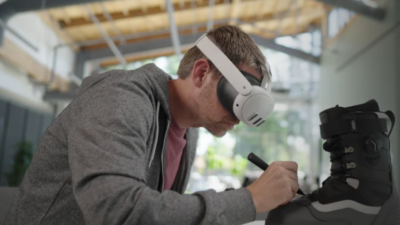Plus, Apple’s powerful new chips and Acer’s unusual new desktop (it’s not at all what you think).
If your resolutions for 2023 involve eating healthier, losing weight or spending more time with loved ones, we can’t help you. But if you resolved to check out more tech, we’ve got you covered with these three new products to help you work better, faster and sweatier (come to think of it, the third one actually might help you lose weight).
Notebook with a Twist
Lenovo announced a lot of new gear at CES 2023, including a refresh of its ThinkPad X1 lineup, but perhaps none was more eye-catching than the ThinkBook Plus Twist, a dizzying new take on the hybrid laptop/tablet form factor.
The ThinkBook Plus Twist is interesting for two reasons, and the first one is in the name: the laptop’s OLED display literally twists atop the keyboard to reveal a second screen on the other side. And that second screen is the second interesting thing about the Twist: it’s no ordinary display but an e-Ink display, the same kind you’d find in an Amazon Kindle or other e-reader.

There are many advantages to e-Ink displays: they’re more comfortable on the eyes, they barely drain the battery, and they provide a natural writing experience with a digital stylus. But e-Ink has its drawbacks too, including a painfully slow refresh rate (12Hz in the Twist) and limited colors, if any (the Twist has a color e-Ink display, but don’t expect anything close to the vibrant hues of the OLED display behind it).
With the Twist, users get the best of both worlds: a comfortable, low power e-Ink display for reading and writing, and a high-res OLED for everything else. Though the Twist doesn’t offer powerhouse performance, its versatility should appeal to any engineer who enjoys digital notetaking and wants to minimize their device count.
The Lenovo ThinkBook Twist will be available in June 2023 starting at $1,649.
Apple Levels Up Again with M2 Pro and M2 Max
Apple has done it again. If you were intrigued by the California company’s custom silicon and bought yourself a new MacBook powered by the M2 chip, prepare to yearn once more for the latest model. Apple has unveiled two new processors, the M2 Pro and M2 Max, which will power the next generation of MacBook Pros and Mac Minis.
Both new chips scale up the architecture of last year’s M2. The M2 Pro comprises 40 billion transistors, twice that of the M2. It offers 12 CPU cores and up to 19 GPU cores, which share 32GB of unified memory with 200GB/s of bandwidth. The M2 Max is bigger yet, made of 67 billion transistors, up to 38 GPU cores, and 96GB of unified memory with a bandwidth of 400GB/s.
The M2 Pro and M2 Max will be available in Apple’s upcoming 14- and 16-inch MacBook Pro models. The M2 and M2 Pro (but not the M2 Max) will power Apple’s new iteration of the Mac Mini, its compact desktop unit.

Apple says that MacBook Pro users will see 30 percent greater graphics performance with the M2 Max compared to the M1 Max. “MacBook Pro once again pushes the limits of graphics memory in a laptop to enable intensive graphics workloads, such as creating scenes with extreme 3D geometry and textures,” said Apple’s press release.
Apple’s silicon has proven extremely popular with users since the M1 chip launched in late 2020, and the chips just keep getting better. The new M2 chips renew the temptation to trade in our PC for a Mac—but there’s still one drawback: the price. The new MacBook Pros start at $2,000 (14-inch, M2 Pro with 16GB memory, 512GB storage) and the M2 Pro-powered Mac Mini starts at $1,300.
Ride Your Desk to Work
Acer’s latest desktop isn’t the kind we’re used to from the computer company—it’s not a desktop PC but a literal desktop, and it’s attached to a bicycle. It’s the Acer eKinekt BD 3, and we can’t decide if it’s crazy or genius.

The Acer eKinekt BD 3 is a bike desk that encourages exercise by allowing users to pedal while they work. “You don’t have to choose between your job and an active lifecycle,” Acer says. Users can adjust the bike’s resistance, seat height and desk position to transition between casual pedaling and an intense workout. A companion app allows riders to monitor their workout stats and history.
Not only does the Acer eKinekt BD 3 keep users active, it also keeps their devices powered up. The bike desk includes two USB-A ports and one USB-C port that can be used to charge devices via pedaling power. Constant cycling at 60 RPM will generate 75 watts, according to Acer.
Busy engineers with little time for exercise may find the eKinekt BD 3 to be a useful way to burn some extra calories. It’ll certainly burn some extra cash: the bike desk will cost $1,000 when it’s available in June.
Want to see more? Watch the video version of this Tech Check.



